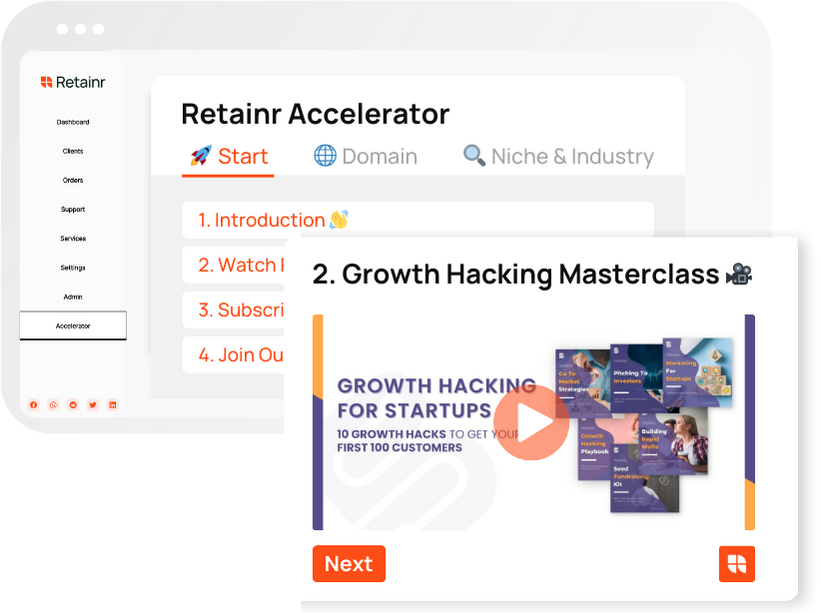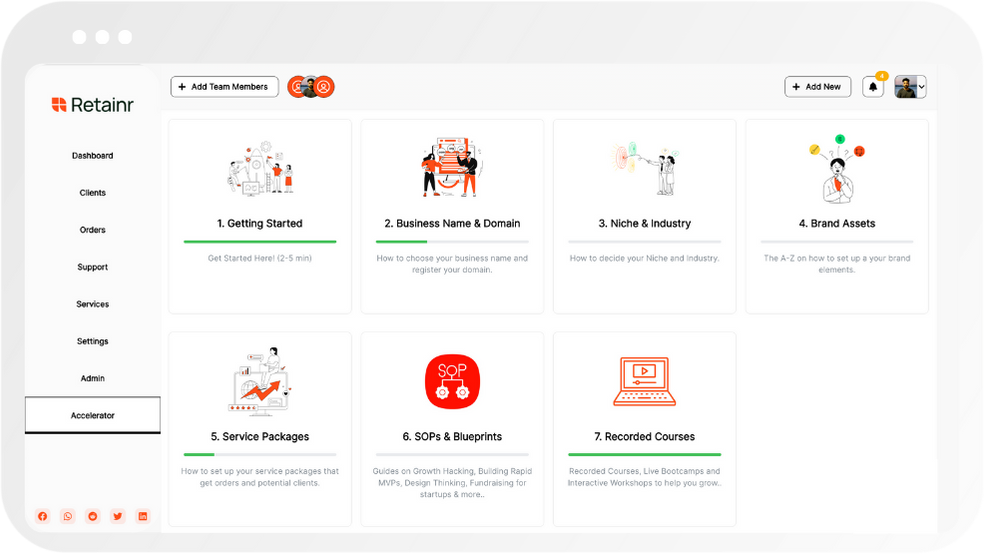
How to Start an E-Commerce Business in 2024
Build with Retainr
Sell your products and services, manage clients, orders, payments, automate your client onboarding and management with your own branded web application.
Get Started1. What are the key considerations when starting an e-commerce business in 2024?
Understanding your Business-model
Before launching an e-commerce business in 2024, it's essential to have a clear understanding of your intended business model. There are various e-commerce models to choose from such as Business-to-Business (B2B), Business-to-Consumer (B2C), Consumer-to-Consumer (C2C) and Consumer-to-Business (C2B). Your chosen model should dictate your business strategies and target audience. For instance, B2B involves selling products or services directly to other businesses, while B2C involves direct selling to consumers.
Key Considerations
The following are the key considerations for starting an e-commerce business:
- Product Selection: Choose products that are in demand but not oversaturated in the market.
- Market Research: Understand your customer base and competition.
- Online Presence: A user-friendly website and active social media accounts.
- Legal Requirements: Comply with all regulatory and legal guidelines.
- Customer Service: Prioritize top-notch customer service to retain clients.
Technological Advancements
2024's e-commerce landscape will be significantly shaped by technological advancements. Following are expectations:
| Technology | Impact |
|---|---|
| Artificial Intelligence | Predict consumer behavior, personalizing online shopping experiences, and enhancing customer service through chatbots. |
| Augmented Reality | Allow customers to virtually try products before purchasing, increasing engagement and conversion rates. |
| Blockchain Technology | Enhance security in transactions, ensure better privacy, decrease fraud and enable better traceability. |
| 5G Connectivity | Offer faster, more reliable connections, resulting in superior user experiences and increasing mobile commerce sales. |
2. How much initial investment is needed to start an e-commerce business in 2024?
Initial Financial Investment for Starting an E-Commerce Business
One important aspect when considering setting up an e-commerce business in 2024 is the financial input. The initial capital for an e-commerce startup will depend on the nature of the business, its scale, and the strategies used in its setup. Nonetheless, a general breakdown of potential expenses can be categorized into groups.
Breakdown of Initial Cost
The setup cost of an e-commerce business can be divided into fixed and variable expenses. The fixed expenses generally include:
- Website Development: Depending on your technical skills, you may need to hire a web developer. The cost can range from $2000 to $5000.
- Hosting & Domain: A secure and fast server can cost around $100 to $200 yearly. The same for the domain name.
- Inventory: The cost of the products to sell. This amount can vary greatly depending on the product type, its prices and the quantity to store.
- Legal Fees: Around $500 to $1000 for business registration and pertinent licenses.
The variable costs will typically include:
- Marketing: A budget will need to be set aside for SEO, PPC, Social Media campaigns etc. This could range between $500 to $2000 a month.
- Professional Fees: Includes services such accountants, which can cost around $200 to $400 a month.
- Packaging & Shipping: These costs will depend on the logistics and product specifics, but it can average from $1 to $3 per item.
Summary of Initial Cost
Given these ranges, see an estimation of the total initial investment for an e-commerce startup in the table below.
| Expense Type | One-Time Costs | Recurring Costs |
|---|---|---|
| Website Development | $2000 - $5000 | N/A |
| Hosting & Domain | $100 - $200 | $100 - $200/year |
| Inventory | Variable | Variable |
| Legal Fees | $500 - $1000 | Depends on legal requirements |
| Marketing | N/A | $500 - $2000/month |
| Professional Fees | N/A | $200 - $400/month |
| Packaging & Shipping | N/A | Variable |
| Total | Variable | Variable |
3. What are the core technologies needed to establish an e-commerce business in 2024?
Core Technologies for E-Commerce
The establishment of a successful e-commerce business in 2024 involves integrating several state-of-the-art technologies. These technological solutions are integral to ensuring efficient business operations, enhanced customer experiences, and optimal growth. They include:
- Content Management System (CMS): A CMS like WordPress, Magento, or Shopify is necessary for managing digital content, e.g., product descriptions and images. It also assists in the timely update of online stores.
- Payment Gateway: This technology is crucial in facilitating online transactions. It securely transmits the data from customer payment portals like credit cards or digital wallets to the banks.
- Customer Relationship Management (CRM): CRM tools such as Salesforce or HubSpot aid in managing relationships with customers. They can track customer behaviour, preferences, and provide valuable insights for personalized offers.
- Artificial Intelligence (AI) and Machine Learning (ML): These technologies are used for personalized recommendations, predictive analytics, customer service chatbots, etc.
Additional Tech Tools
There are several additional tools you can leverage to enhance your e-commerce business operations. These tools can boost the functionality of your online store, improve the user experience, and drive more sales. They include:
| Technology | Use |
|---|---|
| Email Marketing Software | For sending targeted emails to customers, e.g. MailChimp. |
| SEO Tools | To improve web visibility and attract more organic traffic, e.g., SEMRush, Google Analytics. |
| Supply Chain Management Software | To manage inventory and supply chain operations, e.g., Oracle SCM Cloud, SAP SCM. |
Security Technologies
Maintaining security in an e-commerce environment is paramount. Consumers need to feel confident that their personal and financial information is safe. Here are some key security technologies that should be part of any e-commerce setup:
- SSL Certificate: Secure Socket Layer certificates encrypt the connection between your web server and the customer's browser, this is an essential technology for ensuring the secure exchange of data.
- Firewall: A solid firewall system can filter out unauthorised access and threats, providing a first line of defense.
- Data backup: It is critical to regularly backup data to facilitate recovery in case of a data breach or malfunction.
- Two-factor Authentication: This security measure adds an additional layer of verification for user logins, making unauthorized access more difficult.
4. How to create a business plan for an e-commerce startup in 2024?
Understanding your Market
Firstly, you need to identify and understand the market for your e-commerce business. Conduct market research to accurately gauge the demand, potential customers, and competition for your products or services. Draw up a table to visualize your findings:
| Product/Service | Target customers | Competition |
|---|---|---|
| Examples | Examples | Examples |
Additionally, you should:
- Analyze trends that could affect your business.
- Consider the size and demographic of your target market.
- Evaluate your competition's strengths and weaknesses.
Defining your Business Model
The next step is to clearly define your business model. Decide whether your business will operate as a B2B, B2C, C2C, or a combination of these. Understand how your chosen model may affect the way you interact with customers, set pricing strategies, select marketing channels, and pick distribution and delivery methods. Consider:
- Your revenue sources and cost structures.
- Your value proposition to the customers.
- Your customer relationships and channels.
- Key collaborations and resources needed.
Planning your Marketing Strategy
Lastly, outline your marketing strategy. Identify which online and offline channels are best suited to reach your target market. Determine how you can leverage SEO, social media marketing, content marketing, email marketing, and online advertising to drive traffic to your site and convert visitors into customers. Create a table like this:
| Marketing Strategy | Expected Outcome | Implementation Plan |
|---|---|---|
| SEO | Higher visibility | Keyword optimization, technical SEO, etc. |
In your plan, also include a section on:
- Brand positioning and user experience.
- Customer loyalty programs and customer retention strategies.
- Performance metrics to track your marketing effectiveness.
5. How can I select the best platform for my e-commerce store in 2024?
Selecting the Best Platform for Your e-Commerce Store
Choosing the right platform for your e-commerce store in 2024 entails looking into numerous important factors. These range from the functionality and scalability to the safety and pricing of the platform. Below is a process to help you determine the best pick:
- Identify your business requirements: What do you want to achieve with your e-commerce store? Identifying your business needs would involve considering whether you want to sell a large variety of products, the target audiences you are targeting etc.
- Compare the features of different platforms: After identifying your needs, you need to compare different platforms - their features, pros and cons.
- Pricing: You need to consider the pricing of the platform, within your budget and resources.
Important Features to Consider in an E-Commerce Platform
To select the best platform, you also need to consider certain essential features. Below is a list of some you should prioritize:
- User-Friendly Interface: Customers should find it easy to navigate and use your online store.
- SEO capabilities: The platform should have features that make it easy for you to optimize the site for search engines.
- Mobile Compatibility: A good e-commerce platform should be compatible with mobile devices as well.
Top E-commerce Platforms in 2024
Below is a table showcasing some of the top e-commerce platforms in 2024 along with their distinct features they offer on their platforms.
| Platform | User-friendly Interface | SEO Capabilities | Mobile Compatibility |
|---|---|---|---|
| Shopify | Yes | Yes | Yes |
| Magento | Yes | Yes | Yes |
| WooCommerce | Yes | Yes | Yes |
6. What are the legal requirements for setting up an e-commerce business in 2024?
Understanding Legal Requirement Basics
One of the major steps in setting up an e-commerce business is understanding and adhering to the various legal requirements in place. For general conformity, the following steps are crucial:
- Business Registration: Make sure to register your e-commerce business properly and obtaining a business permit and license.
- Tax Compliance: You should get an EIN (Employer Identification Number) and be aware of the sales tax regulations in your area.
- Data Protection Compliance: Your tried-and-true practices should comply with necessary data protection laws, including GDPR (General Data Protection Regulation), CCPA (California Consumer Privacy Act) and PIPEDA (Personal Information Protection and Electronic Documents Act).
Fulfilling E-Commerce Specific Legalities
The e-commerce industry also holds some industry-specific legalities which should not be overlooked. Acquaint yourself with the following:
- Website Terms of Use: Clearly state what is allowed and disallowed on your website in a well detailed 'Terms of Use' page.
- Payment Logistics: Aligning with Federal Trade Commission’s Mail, Internet, or Telephone Order Merchandise Rule for payment policies.
- Shipping & Return Policies: It is mandatory to detail shipping and return policies for your customers visibility.
Legal Requirements Table Overview
| Legal Requirement | Description |
|---|---|
| Business Registration | Proper registration, obtaining business permits and licenses |
| Tax Compliance | Securing an EIN, knowing sales tax regulations |
| Data Protection Compliance | Adhering to GDPR, CCPA, PIPEDA |
| Website Terms of Use | The 'Dos and Don'ts' for use of your website |
| Payment Logistics | Aligning with FTC’s Mail, Internet, or Telephone Order Merchandise Rule |
| Shipping & Return Policies | Detailing shipping and return policies for customer transparency |
7. How can I identify and reach my target audience for an e-commerce business in 2024?
Identifying Your E-Commerce Target Audience
One of the critical factors in starting an e-commerce business is defining your target audience. Here's how you can identify them:
- Conduct Market Research: Identify your competitors and examine their customer base. Look for demographic data such as age, gender, location, and income levels.
- Create Customer Personas: This involves creating detailed profiles of your ideal customers, including their preferences, pain-points, and buying habits.
- Analyse Your Product: Understand who your product or services will benefit the most. Look for the people who have the problem that your product is solving.
- Consider Your Brand: Identify the type of customer who will resonate with your brand's personality and values.
Reaching Your E-Commerce Target Audience
Once your target audience is defined, the next step is to reach them. Use these strategies to connect with your potential customers:
- Social Media Advertising: Consider platforms where your target audience spends most of their time. Use targeted ads to reach specific demographics.
- Email Marketing: Collect email addresses and send out newsletters or promotions to engage potential customers.
- Search Engine Optimization (SEO): Use keywords in your product descriptions and content to draw customers from organic search.
- Content Marketing: Create valuable content that draws potential customers to your website or blog.
E-Commerce Target Audience In 2024
In 2024, the digital landscape could evolve. Leverage the potential advancements to connect with your target audience. There might be a necessity in the consideration of these future aspects:
| Aspect | Potential Change |
|---|---|
| Data Privacy | The importance of data privacy might intensify, making it necessary to prioritise transparency in customer data collection. |
| Voice Search | With the availability of more voice-activated devices, search methods may shift from typing to speaking. |
| Augmented Reality | AR can potentially enhance online shopping by providing customers with a detailed visualisation of products. |
8. What strategies can I adopt to ensure the success of my e-commerce business in 2024?
Understanding Your Customers' Needs
One essential strategy for ensuring success for your e-commerce business is understanding and meeting your customers' needs. You must have a deep understanding of your target market. For this, you can:
- Implement tools like Google Analytics to get insights about your audience
- Conduct customer surveys to get direct feedback
- Use customer testimonials and reviews to improve your services
Maximizing Website Usability
Another important strategy is to prioritize website usability. A user-friendly website leads to better customer satisfaction and increases the likelihood of repeat visits. To achieve this:
- Ensure your website is mobile responsive as more customers are shopping via mobile phones
- Make the checkout process as simple as possible to prevent cart abandonment
- Use high-quality images and provide detailed product descriptions
Website usability can significantly impact your business. This can be illustrated in the table below:
| Website Factor | Impact on E-Commerce Business |
|---|---|
| Mobile Responsiveness | Improved accessibility leading to more potential sales |
| Easy Checkout Process | Lower cart abandonment rates and increase in completed purchases |
| Quality Product Images and Descriptions | Higher customer confidence in products leading to more sales |
Digital Marketing and SEO
Lastly, leveraging digital marketing and SEO is pivotal for driving traffic to your website and improving visibility. You can:
- Invest in SEO to increase organic traffic
- Use email marketing to keep your customers updated about new products or sales
- Implement a social media strategy to engage with your audience
9. How to handle shipping and logistics for an e-commerce business starting in 2024?
Understanding Shipping and Logistics
Before you delve into the e-commerce landscape in 2024, you must understand the basics of shipping and logistics management. Primarily, your operations should involve the efficient storage and movement of your goods. Depending on your target market, you might have to deal with international shipping regulations and customs compliance. Further, you need to arrange secure packaging and ensure timely delivery to promote customer satisfaction.
Choosing Your Shipping Strategy
Thus, deciding on an effective shipping strategy from the onset is crucial. Here's a brief understanding of what your plans could include:
- Offer Free Shipping: This could simply be absorbed in the pricing of the products, or you could set a minimum order value to avail of free shipping.
- Flat Rate Shipping: Regardless of the size, weight, or quantity of the purchased products, charge a single flat rate for delivery.
- Exact Cost Shipping: Pass on the exact cost of delivery to your customer by calculating it during the checkout process.
Opting for a Reliable Logistics Partner
Remember, the logistical success of your e-commerce business relies heavily on your choice of partner. You must make a decision after considering the following factors:
| Aspect | Why it Matters |
|---|---|
| Delivery Network | The wider the network, the more areas you'll be able to service your customers. |
| Shipping Rate | Your choice should be cost-effective and align with your chosen business model. |
| Technology | Ensure that the partner you choose has up-to-date technology for accurate tracking and delivery. |
| Customer Support | Round-the-clock customer support is essential for solving any shipping-related queries or issues. |
10. What are the most effective marketing strategies for a new e-commerce business in 2024?
Understand Your Audience
To create the optimal marketing strategy, understanding your audience is critical. Know your target demographic's age, location, income, interests, and online habits. In 2024, the most common platforms for consumer engagement are likely to be social media (Instagram, Facebook, Twitter, LinkedIn) and email marketing, given their massive user databases and personalized ad targeting options. Here is an illustrative table:
| Option | User Base | Top Features |
|---|---|---|
| Over 1 billion | Story ads, reels, shoppable posts | |
| About 2.8 billion | Targeted ads, groups, Facebook marketplace | |
| 330 million | Promoted tweets, audience insights | |
| Email marketing | N/A | Personalized content, segmentation, A/B testing |
Content Marketing
The algorithms of Google and other major search engines increasingly reward quality content that authentically engages users. Here are three types of content marketing that remain highly relevant in 2024:
- Blogging: High-quality blog posts that answer common customer questions or provide valuable information related to your product niche can significantly improve your SEO and establish your brand as a thought leader.
- Video Content: With the rising popularity of platforms like YouTube and TikTok, creating engaging video content is a powerful way to keep and attract audiences. Tutorial videos, product reviews, and unboxing videos can effectively drive sales.
- Podcasts: Podcasts can position your brand as an industry expert, while also offering an intimate way to connect with your audience. Regular episodes featuring customer testimonials, interviews with industry leaders, and product guides can be highly effective.
Influencer Marketing
By 2024, working with influencers is mainstream. Unlike traditional celebrity endorsements, partnerships with micro or nano influencers (those with fewer followers but higher engagement rates) can be a cost-effective way to reach your target audience. From Instagram stories to TikTok dance challenges, here are three key benefits of influencer marketing:
- Enhance brand awareness.
- Drive swift customer engagement.
- Stimulate direct conversions.
Conclusion
Establishing an E-Commerce Business in 2024
Building an e-commerce business in 2024 can be both exciting and rewarding. Yet, success requires careful and strategic planning. From market research and defining your unique selling proposition to selecting the right business model, creating a compelling web store, sourcing products, and managing operations - there's a lot to consider.
Employ the Right Software
One key aspect of e-commerce success is using the right software to streamline your operations, such as Retainr.io. Using Retainr.io can help you to significantly improve management of your customers, orders, and payments - all within your very own branded app.
Efficient Order and Payment Management
The heart of any successful e-commerce business is efficient order management. With Retainr.io, you can update, revise, and manage orders in a hassle-free environment. It also facilitates seamless integration of payment methods, enabling you to offer your customers a faster and more reliable purchasing process.
Building Strong Customer Relationships
Retaining customers is as vital as acquiring new ones. For e-commerce businesses, establishing strong relationships with customers can translate into repeat business. Retainr.io delivers not only top-notch customer management tools but also modules for cultivating loyalty, ultimately leading to increased customer retention.
Branding Your App
Retainr.io's white-label solution offers the opportunity for you to put your own branding on the app. With this software, you can enhance visibility, strengthen your brand's personality, and provide customers an app they will associate directly with your business.
Take the Next Step
With strategic planning and the right software, 2024 can be the year your e-commerce business takes off. So, why wait? Discover how you can leverage the functionalities of Retainr.io and take your e-commerce business to the next level.
Boost Your Agency Growth
with Retainr Accelerator
Uncover secrets, strategies, and exclusive blueprints to take your agency's growth to the next level — from marketing insights to effective presentations and leveraging technology.

SOPs, Cheatsheets & Blueprints
Leverage 50+ SOPs (valued over $10K) offering practical guides, scripts, tools, hacks, templates, and cheat sheets to fast-track your startup's growth.
Connect with fellow entrepreneurs, share experiences, and get expert insights within our exclusive Facebook community.
.jpg)

Join a thriving community of growth hackers. Network, collaborate, and learn from like-minded entrepreneurs on a lifelong journey to success.

Gain expertise with recorded Courses, Live Bootcamps and interactive Workshops on topics like growth hacking, copywriting, no-code funnel building, performance marketing and more, taught by seasoned coaches & industry experts.

.jpg)

.jpeg)


